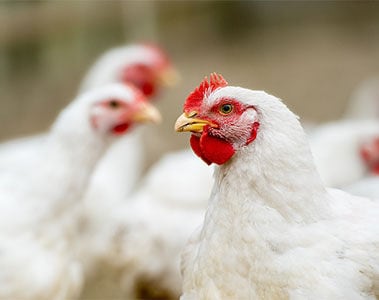
-
Global/EN
- Global
- North America
- Latin America
RONOZYME® HiStarch contains a unique single alpha-amylase, which unlocks the energy in grain-based poultry and piglets feeds by improving starch digestion, resulting to reduced feed costs.
Our experts are always available to help.
If you are an existing customer, please go directly to our Customer Portal.
Corn, sorghum and wheat are major sources of starch energy for poultry. Not all the starch present in those grains can be accessed during digestion. RONOZYME® HiStarch makes it possible to access a greater proportion of the available starch and therefore to obtain more energy from the feed – delivering valuable benefits for poultry operations.
RONOZYME® HiStarch supplements the endogenous amylases produced by animals, improving starch digestion in the gut. Possessing the fastest starch-degrading capability on the market, RONOZYME® HiStarch is a unique single alpha-amylase. It has been shown in trials to outperform all other commercially available exogenous amylases, improving live weight gain and boosting feed conversion rates consistently and significantly.
Releasing increased energy from the diet reduces poultry feed costs and allows greater flexibility in sourcing raw materials. These factors together deliver substantial feed cost savings.
The energy (ME) is significantly increased by at least 100 kcal/kg of corn and sorghum-based diets.
Even further improvements in feed conversion rates can be achieved by using RONOZYME® HiStarch in combination with the feed enzymes RONOZYME® HiPhos (phytase) and RONOZYME® WX (xylanase).
RONOZYME® HiStarch is extremely flexible and is precisely tailored to the needs of the feed manufacturing industry. It combines outstanding heat stability with a free-flowing and dust-free CT (coated thermo-stable) form for use in premix, basemix and finished feeds.
Broilers: 100 g/mT - 150 g/mT
Always check and comply with local regulations
Certain statements may not be applicable in all geographical regions. Product associated claims may differ based on government requirements.
Product availability may vary by country, please contact us for more information.
Corn, sorghum and wheat are major sources of starch energy for piglets. Not all the starch present in those grains can be accessed during digestion. RONOZYME® HiStarch makes it possible to access a greater proportion of the available starch and therefore to obtain more energy from the feed – delivering valuable benefits for piglets’ operations.
RONOZYME® HiStarch supplements the endogenous amylases produced by animals, improving starch digestion in the gut. Possessing the fastest starch-degrading capability on the market, RONOZYME® HiStarch is a unique single alpha-amylase. It has been shown in trials to outperform all other commercially available exogenous amylases, improving live weight gain and boosting feed conversion rates consistently and significantly.
Releasing increased energy from the diet reduces piglets feed costs and allows greater flexibility in sourcing raw materials. These factors together deliver substantial feed cost savings.
The energy (ME) is significantly increased by at least 100 kcal/kg of corn and sorghum-based diets.
Even further improvements in feed conversion rates can be achieved by using RONOZYME® HiStarch in combination with the feed enzymes RONOZYME® HiPhos (phytase) and RONOZYME® WX (xylanase).
RONOZYME® HiStarch is extremely flexible and is precisely tailored to the needs of the feed manufacturing industry. It combines outstanding heat stability with a free-flowing and dust-free CT (coated thermo-stable) form for use in premix, basemix and finished feeds.
Higher energy release, reduced feed costs
Broilers: 100 g/mT - 150 g/mT
Always check and comply with local regulations
Certain statements may not be applicable in all geographical regions. Product associated claims may differ based on government requirements.
Product availability may vary by country, please contact us for more information.